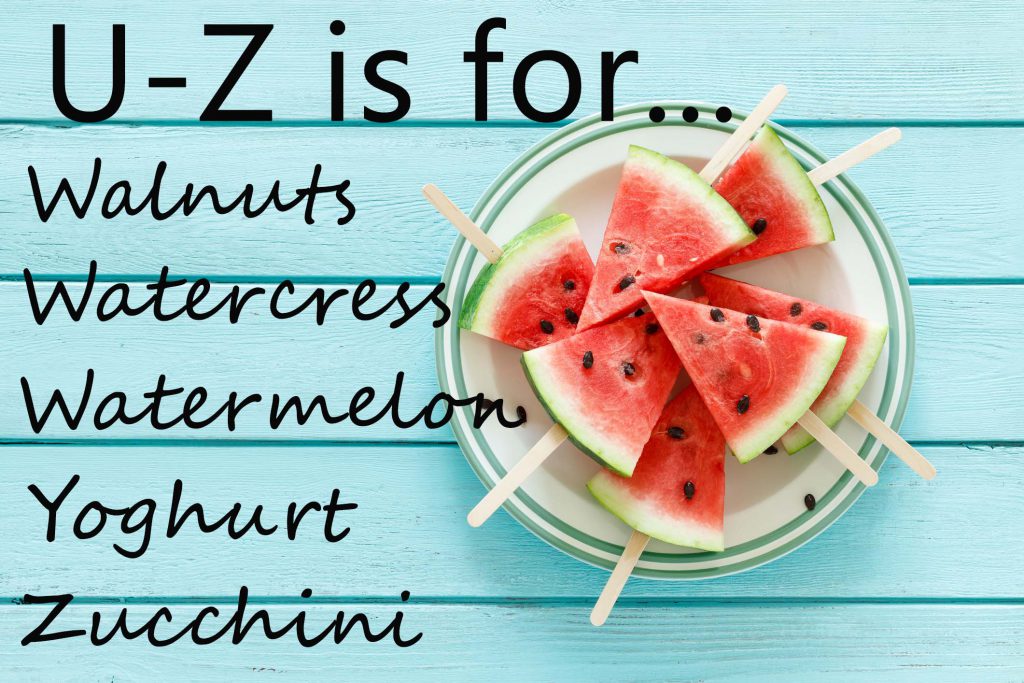Healthy Alphabet: U-Z is For…Five Foods that are Good For You
by Karen Rollins Aug 3, 2020

We are constantly bombarded with information about what we should and shouldn’t be eating, which can become confusing.
Yello has decided to go for a simple approach and provide an alphabetical guide to some of the healthiest foods you can add to your diet.
We’ll be going from A to Z and listing up to five foods that are packed with minerals and vitamins while also providing nutritional facts on their health benefits.
We’ve gone from A to T. So, now it’s time for our final set of letters U-Z.
Walnuts
Walnuts are one of the most nutritionally dense nuts available. They are an extremely rich source of healthy fats, antioxidants, fibre, vitamins, and minerals.
The most common variety is the English walnut.
Walnuts are available raw or roasted, shelled or unshelled, salted or unsalted. They can be used in a variety of recipes or eaten as a healthy snack.
Nutrition facts (117 grams):
* 765 calories (38% daily value (DV))
* 17.8 grams of protein (36% DV)
* 7.8 grams of dietary fibre (31% DV)
* 7.2 grams of saturated fat (36% DV)
* 10623 milligrams (mg) of total Omega-3 fatty acids
* 4.0 mg of manganese (200% DV)
* 1.9 mg of copper (93% DV)
* 115 micrograms (mcg) of folate (29% DV)
Watercress
Watercress is a dark, leafy green that grows in natural spring water. It is a member of the cruciferous family along with kale, broccoli, and Brussels sprouts.
Traditionally, people have used watercress as a garnish, but recently it has become more popular as a food due to its dense nutritional content.
Watercress is full of essential vitamins and minerals, including vitamin E, thiamine, folate, and vitamin K. It can be added to salads, sandwiches, and pasta.
Nutrition facts (100 grams):
* 11 calories (1% DV)
* 2.3 grams of protein (5% DV)
* 0.5 grams of dietary fibre (2% DV)
* 95.1 grams of water
* 250 mcg of vitamin K (312% DV)
* 43.0 mg of vitamin C (72% DV)
* 3191 International Units (IU) of vitamin A (64% DV)
* 0.2 mg of manganese (12% DV)
Watermelon
Watermelons are a huge fruit which can grow to the size of a basketball. They have a thick, green skin with pink flesh and black seeds.
Watermelons are a refreshing fruit, packed with nutrients and vitamins, along with antioxidants and amino acids. They are made up of about 92% water.
The seeds of watermelons are also good for you, although they are high in calories.
Nutrition facts (1 wedge):
* 85.8 calories (4% DV)
* 1.1 grams of dietary fibre (5% DV)
* 1.7 grams of protein (3% DV)
* 23.2 mg of vitamin C (39% DV)
* 1627 IU of vitamin A (33% DV)
* 320 mg of potassium (9% DV)
* 28.6 mg of magnesium (7% DV)
* 0.1 mg of vitamin B6 (6% DV)
Yoghurt
Yoghurt is a semi-solid fermented milk product which originated in Bulgaria.
It is mainly made from cows’ milk but can also be used with goat’s and sheep’s milk or even plant-based, which is dairy-free.
Yoghurt with active cultures, also known as probiotics, may help certain gastrointestinal conditions such as constipation and irritable bowel disease.
Nutrition facts (1 container plain, low fat / 227 grams):
* 143 calories (7% DV)
* 11.9 grams of protein (24% DV)
* 16.0 grams of carbohydrate (5% DV)
* 2.3 grams of saturated fat (11% DV)
* 415 mg of calcium (42% DV)
* 327 mg of phosphorus (33% DV)
* 1.3 mcg of vitamin B12 (21% DV)
* 531 mg of potassium (15% DV)
Zucchini (also known as courgette)
Zucchinis, also known as courgettes, resemble a cucumber but they belong to the same family as marrow, squash, and pumpkin.
The most common are dark green, but they can also be yellow and pale green.
Zucchinis are quite a versatile vegetable and can be eaten raw or cooked. They can also make a great substitute for pasta.
Nutrition facts (100 grams, cooked, boiled with salt):
* 16.0 calories (1% DV)
* 0.6 grams of protein (1% DV)
* 1.4 grams of dietary fibre (6% DV)
* 1117 IU of vitamin A (22% DV)
* 239 mg of sodium (10% DV)
* 4.6 mg of vitamin C (8% DV)
* 0.2 mg of manganese (9% DV)
* 253 mg of potassium (7% DV)
This is the final instalment of the healthy food alphabet in this series. Click to take a look at the previous A, B, C, D, E, F,G, H, I, J, K, L, M, N, O, P, Q & R, S and T articles.
Sources: The Food Coach, Nutrition Data, Healthline, Medical News Today, Livescience, WebMD and EatingWell.







